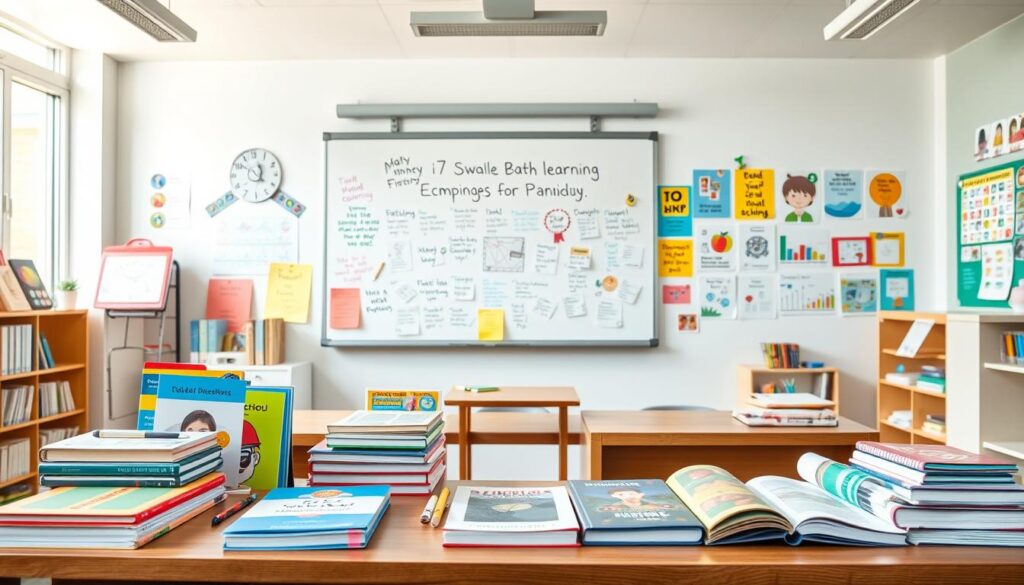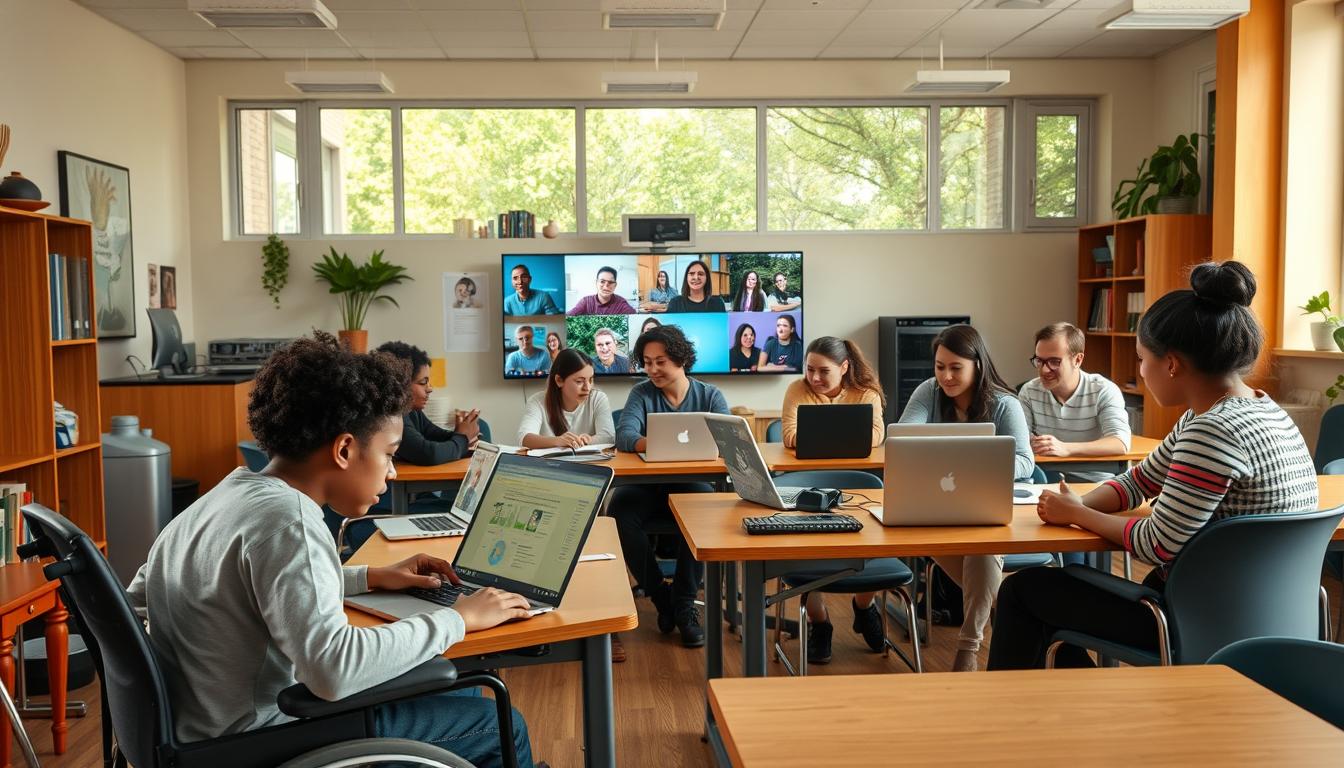During the pandemic, 7 million U.S. students with disabilities faced significant accessibility challenges. A staggering 76% of parents felt their children couldn’t effectively learn remotely. This shift highlighted gaps in digital accessibility and the urgent need for inclusive solutions.
Platforms like ConexED have emerged as vital tools, offering visual learning aids to bridge these gaps. However, a 2020 survey revealed that 74% of parents reported academic skill loss among their children. This underscores the importance of addressing professional development and accessibility in education.
Universal Design principles play a crucial role in creating equitable learning environments. By integrating these principles, we can ensure that all students, regardless of their needs, have access to quality education.
Key Takeaways
- 7 million U.S. students with disabilities faced accessibility challenges during the pandemic.
- 76% of parents felt their children struggled with remote learning.
- Platforms like ConexED provide visual tools to support learning.
- 74% of parents reported academic skill loss in 2020.
- Universal Design principles are essential for digital accessibility.
Understanding the Challenges of Online Learning for Students with Disabilities
The shift to remote education revealed significant gaps in accessibility for many individuals. Students with disabilities often face unique barriers that hinder their ability to fully engage in digital learning environments. These challenges range from technical issues to systemic shortcomings in support systems.
Barriers to Accessibility and Engagement
One major issue is the digital divide. About 33% of K-12 learners lack reliable internet access, making it difficult for them to participate in virtual classes. This problem is even more pronounced for those with disabilities, who may require specialized tools or accommodations.
Another critical barrier is teacher preparedness. A 2014 survey found that only 3% of educators felt ready to teach special education remotely. This lack of training can lead to ineffective implementation of Individualized Education Programs (IEPs), leaving many students without the support they need.
The Impact of Remote Learning on Special Education
Remote learning has also highlighted emotional and logistical challenges. Tools like ConexED’s Quick Check-In help monitor emotional health, but many schools still struggle to address these needs effectively. Additionally, food insecurity affects 70% of disabled college students, further complicating their ability to focus on education.
These issues underscore the importance of addressing accessibility and engagement in education. By tackling these problems, we can create a more inclusive environment for all learners.
Online Learning for Students with Disabilities: Challenges and Solutions
Navigating virtual classrooms has proven difficult for individuals requiring specialized support. Many face barriers that hinder their ability to fully engage in digital environments. These issues range from technical limitations to systemic gaps in resources.
Common Obstacles Faced by Students
One major challenge is the lack of reliable internet access. About 33% of K-12 learners struggle with connectivity, making participation in virtual classes difficult. This issue is even more pronounced for those needing accommodations like assistive technologies.
Another hurdle is teacher preparedness. A 2014 survey found that only 3% of educators felt ready to teach special education remotely. This gap often leads to ineffective implementation of Individualized Education Programs (IEPs).
Research-Backed Strategies to Overcome Them
Effective practices include 4-6 weekly teacher/student interactions, as recommended by research. Partnerships like Google/Microsoft Education with the Educating All Learners coalition are also making strides in addressing these issues.
REL Mid-Atlantic’s four cornerstones—professional development, family engagement, accessibility, and personalization—provide a roadmap for success. For example, ConexED’s simultaneous whiteboard and screen sharing features have proven effective in enhancing engagement.
ADA-compliant captioning standards for media and a 3-step communication protocol for parent-teacher collaboration further ensure inclusivity. These strategies create a more supportive and accessible learning environment.
The Role of Technology in Inclusive Education
Technology has become a cornerstone in creating inclusive educational spaces. It bridges gaps and ensures that every learner, regardless of their needs, can thrive. From assistive tools to innovative platforms, technology is reshaping how we approach accessibility in education.
Essential Tools for Accessibility
Accessibility tools are vital for creating equitable learning environments. Screen readers, for example, ensure that visually impaired learners can navigate digital content. Platforms like Canvas and Blackboard have undergone rigorous accessibility audits to meet WCAG 2.1 standards.
Dictation software, such as Dragon NaturallySpeaking, offers high accuracy rates for students with motor impairments. These tools not only enhance learning but also empower individuals to participate fully in their education.
Platforms Designed for Diverse Needs
Innovative platforms are addressing the unique needs of learners. ConexED, for instance, offers FERPA-compliant session archiving and tactile interface alternatives. These features ensure that all users can engage effectively in virtual settings.
Microsoft Immersive Reader is another success story, providing text-to-speech and translation options. Such platforms align with Universal Design Learning principles, making education more inclusive.
For more insights on how technology is transforming education, explore the role of inclusive technology in bridging divides.
Universal Design for Learning (UDL) Principles
Universal Design for Learning (UDL) principles are transforming education by focusing on inclusivity. These principles ensure that every learner, regardless of their needs, can thrive. By emphasizing flexibility and accessibility, UDL creates equitable learning environments.
Multiple Means of Engagement
Engagement is a cornerstone of UDL. Harvard University saw a 34% increase in student engagement after implementing UDL training. This approach encourages educators to use multi-modal content delivery, such as videos, interactive tools, and hands-on activities.
Khan Academy is a prime example of this strategy. Their platform offers diverse resources that cater to different learning styles. By providing multiple ways to engage, educators can foster a deeper connection with the material.
Flexible Representation and Expression
Flexibility in representation and expression is another key aspect of UDL. CAST’s framework highlights the importance of offering varied ways for students to demonstrate their understanding. This could include written assignments, oral presentations, or creative projects.
Pearson’s adoption of UDL-certified textbooks has shown significant success. These resources provide alternative formats, ensuring that all learners can access and engage with the content. By embracing these principles, educators can unlock every student’s ability to succeed.
- Apply Thich Nhat Hanh’s educational philosophy to UDL implementation for holistic growth.
- Use a 5-step UDL lesson planning process to structure inclusive lessons effectively.
- Analyze case studies like UW’s curb cut implementation to understand real-world applications.
Professional Development for Educators
Educators play a pivotal role in shaping accessible and inclusive learning environments. To meet the demands of virtual instruction, they need specialized skills and ongoing training. A 2016 study showed a 170% boost in competency with virtual professional development, highlighting its effectiveness.
Training Teachers for Virtual Instruction
Virtual classrooms require a unique set of skills. Programs like Google for Education’s 12-week certification in assistive technologies provide hands-on training. Research shows that micro-credentialing improves retention by 68%, making it a valuable approach for educators.
Broward County’s 3-tier professional development model is another success story. It focuses on building competency through structured training and real-world application. This approach ensures that teachers are well-prepared to support diverse learners.
Building Competency in Assistive Technologies
Assistive technology is essential for creating inclusive classrooms. The EdTech Evidence Exchange’s implementation science framework offers a roadmap for integrating these tools effectively. By following this framework, educators can ensure that all learners have the support they need.
Quality Matters’ rubric for course design standards is another valuable resource. It provides guidelines for creating accessible and engaging virtual learning experiences. These tools, combined with ongoing research, empower educators to deliver high-quality instruction.
- Google for Education’s 12-week certification program enhances skills in assistive technologies.
- Micro-credentialing improves retention by 68%.
- Broward County’s 3-tier PD model focuses on structured training.
- Quality Matters’ rubric ensures accessible course design.
Family Engagement in Distance Learning

Family engagement has become a cornerstone of successful distance learning. When parents actively participate in their children‘s education, it creates a supportive environment that fosters academic growth. Research by Smith et al. (2016) highlights a paradigm shift in parental roles, emphasizing their critical involvement in remote education.
How Parents Can Support Learning at Home
Parents can play a vital role by creating a structured routine for their children. Tools like the “IEP At Home” toolkit provide practical strategies for supporting individualized education plans. Additionally, platforms like ParentSquare enhance communication, with analytics showing improved engagement rates.
Johns Hopkins’ 5:1 positive feedback ratio strategy is another effective approach. This method encourages parents to provide five positive comments for every constructive critique, fostering a positive learning environment at home.
Collaborating with Schools for Success
Effective collaboration between families and schools is essential. Montgomery County’s family literacy nights have shown significant outcomes, strengthening the bond between school and home. Similarly, the Remind app boasts a 94% parent engagement rate, ensuring consistent communication.
Family portals have also proven effective, with an 82% improvement in IEP compliance. These tools ensure that parents are informed and involved in their children‘s education, creating a unified approach to learning.
Legal Considerations for Accessible Online Learning
Ensuring accessibility in education involves navigating complex legal frameworks. These frameworks are designed to protect the rights of individuals and promote equitable access to learning opportunities. Understanding these legal considerations is essential for educators, institutions, and policymakers.
Compliance with ADA and Section 504
The Americans with Disabilities Act (ADA) and Section 504 of the Rehabilitation Act are foundational laws in this area. They mandate that educational institutions provide equal access to programs and services. For example, the Department of Justice has reached settlements with institutions like UC Berkeley and MIT to ensure compliance with these laws.
OCR resolution agreements often require adherence to WCAG 2.1 AA standards. These standards ensure that digital content is accessible to all users, including those with disabilities. Institutions must prioritize these guidelines to avoid legal repercussions and foster inclusivity.
Recent Cases and Their Implications
Recent cases have shaped the legal landscape of accessible education. The Harvard/MIT captioning lawsuit, for instance, highlighted the importance of providing accurate captions for video content. This case set a precedent for other institutions to follow.
Blackboard Ally’s automated compliance reports have also become a valuable tool for institutions. These reports help identify accessibility gaps and ensure that digital content meets legal standards. EDUCAUSE’s risk assessment matrix further aids institutions in evaluating their readiness to address accessibility concerns.
- Analyze the outcomes of the Harvard/MIT captioning lawsuit.
- Break down OCR’s 2016 Dear Colleague letter requirements.
- Present Blackboard Ally’s automated compliance reports.
- Discuss EDUCAUSE’s risk assessment matrix.
- Outline the 3-step OCR complaint response protocol.
Creating an Inclusive Online Learning Environment
Building an inclusive environment in education starts with thoughtful design and active participation. By focusing on accessibility and fostering student voice, educators can create spaces where every learner thrives. Research by Boothe et al. (2020) highlights the importance of Universal Design for Learning (UDL) principles in achieving this goal.
Designing Courses with Accessibility in Mind
Effective course design ensures that all learners can access and engage with materials. Tools like Canvas Studio offer interactive transcripts, making content more accessible. VoiceThread’s multimodal discussion boards also enhance participation, with analytics showing a 47% increase in engagement.
Stanford d.school’s equity-centered design framework provides a roadmap for creating inclusive courses. ASU’s universal learner outcomes further emphasize the importance of accessibility in education. Integrating tools like Qualtrics’ accessibility checker ensures that digital content meets high standards.
Encouraging Student Voice and Choice
Empowering learners means giving them a say in their education. Platforms like ConexED have shown that offering choice and fostering student voice leads to higher participation rates. By providing diverse ways to engage, educators can create a more inclusive environment.
Here are some strategies to encourage engagement and choice:
- Use Canvas Studio’s interactive features to make learning more dynamic.
- Leverage VoiceThread’s analytics to identify and support diverse learning styles.
- Apply Stanford d.school’s framework to ensure equity in course design.
- Adopt ASU’s universal learner outcomes to measure inclusivity.
- Integrate Qualtrics’ accessibility checker to identify and address gaps.
By prioritizing accessibility and student involvement, educators can create learning environments where everyone succeeds.
Assistive Technologies That Make a Difference
Innovative tools are transforming how individuals access educational content. These solutions bridge gaps and empower users to engage more effectively. From screen readers to captioning tools, assistive technologies are reshaping accessibility in education.
Screen Readers and Text-to-Speech Tools
Screen readers like JAWS and NVDA are essential for visually impaired users. JAWS offers robust features for navigating complex content, while NVDA is a free, open-source alternative. Both tools provide reliable access to digital materials.
Text-to-speech tools like Kurzweil 3000 and Read&Write support literacy development. Kurzweil excels in multi-sensory learning, while Read&Write integrates seamlessly with everyday applications. These tools ensure that users can engage with content in ways that suit their needs.
Captioning and Sign Language Resources
Accurate captioning is crucial for individuals with hearing impairments. Rev.com guarantees 99% accuracy, making it a trusted choice. AI-powered tools like Otter.ai and Sonix also offer reliable transcription services, enhancing accessibility.
For those who use sign language, SignAll’s ASL recognition technology is groundbreaking. It translates sign language into text in real time, fostering better communication. Microsoft Teams’ live captioning feature also sets a benchmark for inclusivity in virtual meetings.
- Compare Kurzweil 3000 and Read&Write for literacy support.
- Explore AI-powered captioning tools like Otter.ai and Sonix.
- Analyze SignAll’s ASL recognition technology for real-time translation.
- Showcase Microsoft Teams’ live captioning benchmarks.
- Break down Glean’s note-taking assistive features for enhanced learning.
Monitoring Progress and Providing Feedback
Effective education relies on continuous improvement through tracking and refining teaching methods. By focusing on monitoring progress and delivering actionable feedback, educators can ensure that every learner reaches their full potential. This approach is especially critical for diverse learners who require tailored support.
Adaptive Assessments for Diverse Learners
Adaptive assessments are designed to meet the unique needs of each individual. Tools like NWEA MAP Growth offer accommodations that ensure fairness and accuracy. These platforms adjust difficulty levels based on performance, providing a more personalized experience.
DreamBox Learning’s adaptive math pathways are another excellent example. They use real-time data to tailor lessons, ensuring that learners stay engaged and challenged. This approach not only supports academic growth but also builds confidence.
Using Data to Personalize Instruction
Data-driven strategies are transforming how educators approach instruction. PowerSchool’s accessible gradebook features allow teachers to track progress and identify areas for improvement. This tool ensures that no learner is left behind.
GoReact’s video feedback analytics provide another layer of insight. Educators can analyze engagement and comprehension, refining their methods for better outcomes. Similarly, Panorama’s social-emotional learning metrics help address non-academic factors that impact success.
- PowerSchool’s gradebook features enhance accessibility and tracking.
- NWEA MAP Growth offers tailored accommodations for diverse learners.
- DreamBox Learning’s adaptive pathways ensure personalized math instruction.
- GoReact’s analytics provide actionable video feedback.
- Panorama’s metrics support social-emotional learning.
By leveraging these tools, educators can create a more inclusive and effective learning environment. For more insights on how assessments are enhancing learning feedback, explore this resource.
Success Stories: Students Thriving in Online Learning
Success in education often comes from tailored support and innovative approaches. Real-world examples demonstrate how effective accommodations can transform outcomes. Richardson’s 2016 study revealed an 83% pass rate improvement, while ConexED experienced a 200% usage growth. These success stories inspire confidence in the power of personalized solutions.
Case Studies of Effective Accommodations
Several institutions have implemented programs that make a significant impact. Arizona State’s online autism support program provides resources tailored to individual needs. Gallaudet University’s virtual ASL immersion ensures accessibility for deaf and hard-of-hearing learners.
Landmark College’s executive function curriculum helps students with ADHD and other challenges. Boston College’s ADHD coaching outcomes highlight the importance of personalized support. UC Davis’ MIND Institute remote trials showcase innovative approaches to mental health and learning.
Lessons Learned from Real-World Examples
These case studies offer valuable insights. They emphasize the importance of flexibility, personalized support, and innovative tools. For instance, Richardson’s research underscores the need for consistent teacher-student interactions.
Here are key takeaways from these examples:
- Arizona State’s program highlights the value of tailored resources.
- Gallaudet University’s ASL immersion fosters inclusivity.
- Landmark College’s curriculum supports executive function development.
- Boston College’s coaching outcomes demonstrate the impact of personalized strategies.
- UC Davis’ trials reveal the potential of remote mental health solutions.
For more inspiring success stories, explore student success stories that highlight the transformative power of education.
Resources for Educators and Families

Accessible education requires a wealth of resources to support both educators and families. From free tools to expert organizations, these assets play a vital role in creating inclusive environments. Whether you’re looking for practical guides or professional training, there’s something for everyone.
Free Tools and Platforms to Explore
Many platforms offer free tools to enhance accessibility. The National Center on Accessible Educational Materials provides curated resources for diverse needs. Understood.org offers parent advocacy guides, helping families navigate the complexities of education.
ISTE’s inclusive learning network connects educators with innovative strategies. Coursera’s disability inclusion courses provide valuable insights for professionals. These resources ensure that everyone has the support they need to succeed.
Organizations Offering Support and Training
Several organizations are dedicated to fostering inclusivity. The Educating All Learners Alliance toolkit is a comprehensive resource for educators. AFB’s careerConnect mentorship program supports individuals in achieving their career goals.
CAST’s UDL guidelines repository is another excellent resource. It provides actionable strategies for implementing Universal Design for Learning. For more insights, explore the distance learning strategies that can make a difference.
- National Center on Accessible Educational Materials: Curated resources for diverse needs.
- Understood.org: Parent advocacy guides for navigating education.
- ISTE: Inclusive learning network for innovative strategies.
- Coursera: Disability inclusion courses for professionals.
- AFB’s careerConnect: Mentorship program for career support.
Conclusion
Creating inclusive educational spaces requires a collective effort and forward-thinking strategies. By implementing key approaches like Universal Design principles, assistive technologies, and professional development, we can ensure success for all learners. Continuous improvement remains essential to address evolving needs and challenges.
Looking ahead, trends like the 2025 accessibility mandates and initiatives such as the 2023 DOE digital accessibility grants highlight the importance of proactive measures. These efforts not only enhance inclusivity but also demonstrate the future of equitable education.
Collaboration among educators, families, and policymakers is crucial. Together, we can build environments where every individual thrives. For more insights, explore this resource on accessible education.

